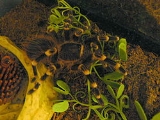
Acanthoscurria brocklehursti
Encyclopedia
The Brazilian black and white tarantula, Acanthoscurria brocklehursti, is a species
of spider
best known for its aggressive eating habits, distinctive coloring, and rapid rate of growth. It is sometimes called the giant black and white tarantula because it can reach a leg span of 18–23 cm (7–9 in)
Feed ALL species of tarantulas roaches, crickets, or other inverts. NEVER feed a tarantula vertebrate prey. Never catch your food from outside and do not dust it with calcium.
Species
In biology, a species is one of the basic units of biological classification and a taxonomic rank. A species is often defined as a group of organisms capable of interbreeding and producing fertile offspring. While in many cases this definition is adequate, more precise or differing measures are...
of spider
Spider
Spiders are air-breathing arthropods that have eight legs, and chelicerae with fangs that inject venom. They are the largest order of arachnids and rank seventh in total species diversity among all other groups of organisms...
best known for its aggressive eating habits, distinctive coloring, and rapid rate of growth. It is sometimes called the giant black and white tarantula because it can reach a leg span of 18–23 cm (7–9 in)
Care
The Brazilian black and white is a rare and colorful tarantula but have a semi- docile & calm nature as it gets older it is recommended for beginners. For the experienced caretaker this tarantula can be a delight to own. Like most tarantulas the Brazilian black and white hates light.Tank
This is a terrestrial spider so it will not burrow the way some other tarantulas do. Floor space is more important than height when choosing a tank. The floor should be covered in something that retains high levels of moisture such as peat or coconut fiber. Anywhere between 1 and 3 inches (3 to 8 cm) deep is best for keeping the high humidity this tarantula needs.Temperature and humidity
The black and white is most comfortable in a temperature range of 80 to 85 °F (29.4 °C). To give this spider the most comfortable habitat the best humidity range is 70 to 80%.Food
These tarantulas do not need to eat very often but if food is provided they will eat. Crickets are the best for this spider. As it gets larger it can be fed pinkie mice and larger insects. However, only feed it mice and other vertebrates occasionally.Feed ALL species of tarantulas roaches, crickets, or other inverts. NEVER feed a tarantula vertebrate prey. Never catch your food from outside and do not dust it with calcium.

